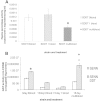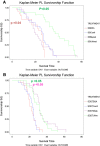The effect of multiple blood-feeding on the longevity and insecticide resistant phenotype in the major malaria vector Anopheles arabiensis (Diptera: Culicidae)
- PMID: 25150975
- PMCID: PMC4161849
- DOI: 10.1186/1756-3305-7-390
The effect of multiple blood-feeding on the longevity and insecticide resistant phenotype in the major malaria vector Anopheles arabiensis (Diptera: Culicidae)
Abstract
Background: Anopheles arabiensis is a major malaria vector in Africa. Adult females are likely to imbibe multiple blood meals during their lifetime. This results in regular exposure to potential toxins and blood-meal induced oxidative stress. Defence responses to these stressors may affect other factors of epidemiological significance, such as insecticide resistance and longevity. The aims of this study were to examine the effect of multiple blood-feeding on insecticide tolerance/resistance with increasing age, to assess the underlying biochemical mechanisms for the responses recorded, and to assess the effect of multiple blood-feeding on the life histories of adult females drawn from insecticide resistant and susceptible laboratory reared An. arabiensis.
Methods: Laboratory reared An. arabiensis females from an insecticide resistant and an insecticide susceptible colony were offered either a single blood meal or multiple blood meals at 3-day intervals. Their tolerance or resistance to insecticide was then monitored by WHO bioassay four hours post blood-feeding. The biochemical basis of the phenotypic response was assessed by examining the effect of blood on detoxification enzyme activity and the effect of blood-meals on detoxification enzyme activity in ageing mosquitoes.
Results: Control cohorts that were not offered any blood meals showed steadily decreasing levels of insecticide tolerance/resistance with age, whereas a single blood meal significantly increased tolerance/resistance primarily at the age of three days. The expression of resistance/tolerance in those cohorts fed multiple blood meals generally showed the least variation with age. These results were consistent following exposure to DDT and pyrethroids but not to malathion. Multiple blood-meals also maintained the DDT and permethrin resistant phenotype, even after treatment females had stopped taking blood-meals. Biochemical analysis suggests that this phenotypic effect in resistant females may be mediated by the maintenance of increased glutathione s-transferase activity as a consequence of multiple blood-feeding. Multiple blood-feeding increased the longevity of insecticide resistant females regardless of their mating status, but only increased the longevity of unmated susceptible females.
Conclusion: These data suggest that multiple blood-feeding confers a competitive advantage to insecticide resistant females by increased longevity and maintenance of the expression of resistance with age.
Figures






Similar articles
-
The effect of elevated temperatures on the life history and insecticide resistance phenotype of the major malaria vector Anopheles arabiensis (Diptera: Culicidae).Malar J. 2017 Feb 14;16(1):73. doi: 10.1186/s12936-017-1720-4. Malar J. 2017. PMID: 28193292 Free PMC article.
-
The Role of Oxidative Stress in the Longevity and Insecticide Resistance Phenotype of the Major Malaria Vectors Anopheles arabiensis and Anopheles funestus.PLoS One. 2016 Mar 10;11(3):e0151049. doi: 10.1371/journal.pone.0151049. eCollection 2016. PLoS One. 2016. PMID: 26964046 Free PMC article.
-
The effect of larval nutritional deprivation on the life history and DDT resistance phenotype in laboratory strains of the malaria vector Anopheles arabiensis.Malar J. 2013 Feb 1;12:44. doi: 10.1186/1475-2875-12-44. Malar J. 2013. PMID: 23368928 Free PMC article.
-
The effects of ingestion of hormonal host factors on the longevity and insecticide resistance phenotype of the major malaria vector Anopheles arabiensis (Diptera: Culicidae).PLoS One. 2017 Jul 11;12(7):e0180909. doi: 10.1371/journal.pone.0180909. eCollection 2017. PLoS One. 2017. PMID: 28700639 Free PMC article.
-
The effect of a single blood meal on the phenotypic expression of insecticide resistance in the major malaria vector Anopheles funestus.Malar J. 2008 Oct 31;7:226. doi: 10.1186/1475-2875-7-226. Malar J. 2008. PMID: 18973704 Free PMC article.
Cited by
-
Effect of environmental variables and kdr resistance genotype on survival probability and infection rates in Anopheles gambiae (s.s.).Parasit Vectors. 2018 Oct 26;11(1):560. doi: 10.1186/s13071-018-3150-8. Parasit Vectors. 2018. PMID: 30367663 Free PMC article.
-
Quantifying late-stage host-seeking behaviour of Anopheles gambiae at the insecticidal net interface using a baited-box bioassay.Malar J. 2020 Apr 7;19(1):140. doi: 10.1186/s12936-020-03213-9. Malar J. 2020. PMID: 32264900 Free PMC article.
-
Multiple blood feeding in mosquitoes shortens the Plasmodium falciparum incubation period and increases malaria transmission potential.PLoS Pathog. 2020 Dec 31;16(12):e1009131. doi: 10.1371/journal.ppat.1009131. eCollection 2020 Dec. PLoS Pathog. 2020. PMID: 33382824 Free PMC article.
-
The effect of elevated temperatures on the life history and insecticide resistance phenotype of the major malaria vector Anopheles arabiensis (Diptera: Culicidae).Malar J. 2017 Feb 14;16(1):73. doi: 10.1186/s12936-017-1720-4. Malar J. 2017. PMID: 28193292 Free PMC article.
-
Wolbachia strains wMel and wAlbB differentially affect Aedes aegypti traits related to fecundity.Microbiol Spectr. 2024 Apr 2;12(4):e0012824. doi: 10.1128/spectrum.00128-24. Epub 2024 Mar 14. Microbiol Spectr. 2024. PMID: 38483475 Free PMC article.
References
-
- Sinka M, Bangs M, Manguin S, Coetzee M, Mbogo C, Hemingway J, Patil A, Temperley W, Gething P, Kabaria C, Okara R, Van Boeckel T, Godfray HC, Harbach R, Hay S. The dominant Anopheles vectors of human malaria in Africa, Europe and the Middle East: occurrence data, distribution maps and bionomic precis. Parasit Vectors. 2010;3:117. doi: 10.1186/1756-3305-3-117. - DOI - PMC - PubMed
-
- Barlow F, Hadaway AB. Effects of age, sex and feeding on the susceptibility of mosquitoes to insecticides. Ann Trop Med Parasitol. 1956;50(4):438–443. - PubMed
Publication types
MeSH terms
Substances
LinkOut - more resources
Full Text Sources
Other Literature Sources
Medical
Miscellaneous

